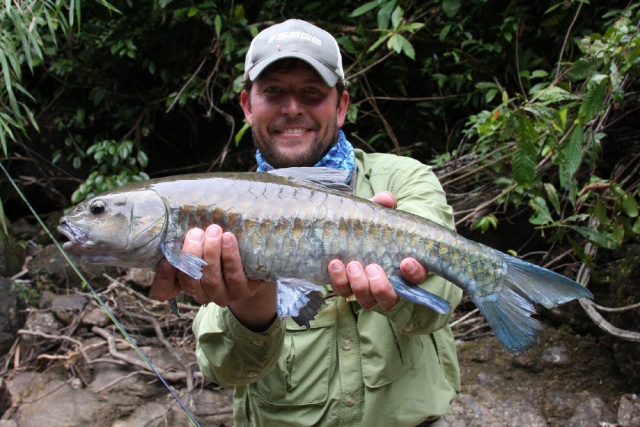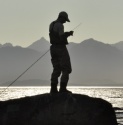Fd: Could you briefly tell us about the beginnings of fly fishing in the Himalayas? Do you know about the first expeditions?
Bryant: As the famous British hunter-conservationist Jim Corbett wrote in 1944, “Fishing for mahseer is, in my opinion, the most fascinating of all field sports.” I think he may be right! Of course, Mr. Corbett was not the first to toss fly spoons at the hardest fighting freshwater fish in the world on the end of a silk casting line. His predecessors from England brought fly tackle of the era in the latter half of the nineteenth century as they explored the region and its colonial potential. However, once 1947 and the dawn of Indian independence came to pass, recreational fishing for mahseer became lost in time until a resurgence in the conservation movement of the 1970s.
Fd: How was it that you started fishing these areas?
Bryant: In 2007, I was contacted by a Bhutanese-American company that was building a recreation lodge. Although they offered rafting, kayaking, biking and trekking, there was essentially no knowledge base regarding modern fly fishing in Bhutan. I was hired to “assess the fishability of the kingdom” and spent a month doing exactly that. It was the best job I’ve ever had.
 Fd: What kind of Mahseer species do you go for? And is the fight as good as they say?
Fd: What kind of Mahseer species do you go for? And is the fight as good as they say?Bryant: There are many types of mahseer throughout Asia and the Himalayas. In India, I focus entirely on the Golden Mahseer (tor putitora). Bhutan offers opportunities at both the Golden and the Chocolate Mahseer. In Thailand, I guide for Blue Mahseer (t. strecheyi) and Thai Mahseer (t. tambroides). I am currently planning an expedition for Red Mahseer in Malaysia.
Mahseer have a reputation as the hardest fighting freshwater fish in the world. They certainly compete for the title. Are south American Golden Dorado harder fighters? North American Steelhead? African Tigerfish? Arapaima? I guess I need to do more research with my fly rod to be certain!
Fd: How do you fish for them? What kind of techniques and flies do you use?
Bryant: One of the wonderful aspects of pursuing mahseer with a fly rod is that techniques are still being tested and developed. Since very few fishermen have fished for mahseer, there is much left to discover. Mahseer are omnivores, therefore they feed on baitfish, insects, detritus and decaying flesh… Even fruit and leaves! Some of the techniques that work well are swinging minnow patterns with one and two-handed rods, using sizeable stonefly-type nymphs or dead-drifting large terrestrial dry flies.
 Fd: What can you tell us about Snow Trout and their nickname “Bhutanese Bonefish”?
Fd: What can you tell us about Snow Trout and their nickname “Bhutanese Bonefish”?Bryant: Snow Trout are ciprinids (carp) as are mahseer. Though they have a trout-like shape, their tails are oversized for their bodies in order to fight the massive monsoon runoff flows. As a result, Snow Trout will take an angler to his backing every time. I coined the nickname because it reminded me of the initial run of bonefish across a wide open saltwater flat.
Fd: What about the Himalayan browns?
Bryant: Hooking brown trout in the Himalayas is a fun respite from throwing larger rods and weighted line for the massive mahseer. My wife and I were fishing in Bhutan in 2010 and she hooked a very large brown. Even though she is an accomplished guide, the fish got the best of her and broke off. The next day, minutes after she had accepted my marriage proposal, we fished a nearby run and I hooked and eventually landed a hefty brownie. Upon inspection, I noticed a small imitation fly with a few inches of tippet in the corner of its mouth. Amazingly, it was the same fish and is a memory we will never forget!
Fd: What can you tell us about the adventure of going after these species?
Bryant: Fly fishing in the Himalayas is an unbelievable experience and something every adventurous angler should experience once in their life… At least! With each expedition, with every new river, I discover more about the species I pursue and the waters in which they live. Casting flies in the shadows of the highest mountains in the world for arguably the world’s hardest-fighting river fish in rivers that have often never been fished is unique. What makes it even more enjoyable, memorable and meaningful are the friendships I have found along the way.
For more about catching mahseers in the Himalayas, you can contact Bryant at the Fd Directory here: Bryant Dunn














